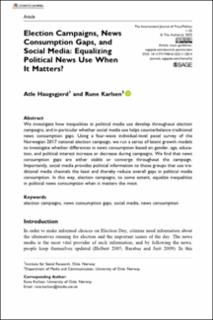| dc.contributor.author | Haugsgjerd, Atle | |
| dc.contributor.author | Karlsen, Rune | |
| dc.date.accessioned | 2023-02-02T07:56:13Z | |
| dc.date.available | 2023-02-02T07:56:13Z | |
| dc.date.created | 2022-07-16T20:54:04Z | |
| dc.date.issued | 2022 | |
| dc.identifier.issn | 1940-1612 | |
| dc.identifier.uri | https://hdl.handle.net/11250/3047860 | |
| dc.description.abstract | We investigate how inequalities in political media use develop throughout election campaigns, and in particular whether social media use helps counterbalance traditional news consumption gaps. Using a four-wave individual-level panel survey of the Norwegian 2017 national election campaign, we run a series of latent growth models to investigate whether differences in news consumption based on gender, age, education, and political interest increase or decrease during campaigns. We find that news consumption gaps are either stable or converge throughout the campaign. Importantly, social media provides political information to those groups that use traditional media channels the least and thereby reduce overall gaps in political media consumption. In this way, election campaigns, to some extent, equalize inequalities in political news consumption when it matters the most. | |
| dc.description.abstract | Election Campaigns, News Consumption Gaps, and Social Media: Equalizing Political News Use When It Matters? | |
| dc.language.iso | eng | |
| dc.title | Election Campaigns, News Consumption Gaps, and Social Media: Equalizing Political News Use When It Matters? | |
| dc.title.alternative | Election Campaigns, News Consumption Gaps, and Social Media: Equalizing Political News Use When It Matters? | |
| dc.type | Peer reviewed | |
| dc.type | Journal article | |
| dc.description.version | publishedVersion | |
| dc.source.journal | The International Journal of Press/Politics | |
| dc.identifier.doi | 10.1177/19401612221112014 | |
| dc.identifier.cristin | 2038529 | |
| dc.relation.project | Norges forskningsråd: 249687 | |
| cristin.ispublished | true | |
| cristin.fulltext | original | |
| cristin.qualitycode | 2 | |
